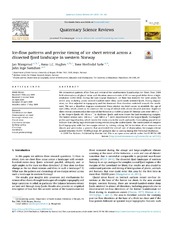Ice-flow patterns and precise timing of ice sheet retreat across a dissected fjord landscape in western Norway
| dc.contributor.author | Mangerud, Jan | |
| dc.contributor.author | Hughes, Anna L.C. | |
| dc.contributor.author | Sæle, Tone Herfindal | |
| dc.contributor.author | Svendsen, John-Inge | |
| dc.date.accessioned | 2020-03-13T07:59:09Z | |
| dc.date.available | 2020-03-13T07:59:09Z | |
| dc.date.issued | 2019-06 | |
| dc.Published | Mangerud J, Hughes A.L.C., Sæle TH, Svendsen J.. Ice-flow patterns and precise timing of ice sheet retreat across a dissected fjord landscape in western Norway. Quaternary Science Reviews. 2019;214:139-163 | eng |
| dc.identifier.issn | 0277-3791 | en_US |
| dc.identifier.issn | 1873-457X | en_US |
| dc.identifier.uri | https://hdl.handle.net/1956/21480 | |
| dc.description.abstract | We reconstruct patterns of ice flow and retreat of the southwestern Scandinavian Ice Sheet, from 2900 field observations of glacial striae and elevation measurements of 60 ice-marginal-deltas from a high-resolution LiDAR DEM. During the Last Glacial Maximum, ice flow was towards the west across the entire area, including across several-hundred meter deep north-south oriented fjords. During deglaciation, ice flow adjusted to topography and the dominant flow direction switched towards the south-west. We use a shoreline diagram constructed from relative sea-level curves to establish the age of each delta, which allows us to constrain the timing of retreat with almost decadal precision. Rapid ice sheet retreat commenced at the onset of the Holocene at 11,600 cal years BP. Retreat rates were 160 m a−1 in the deepest fjords, 60–80 m a−1 in shallower fjords, and even slower for land-terminating margins. The fastest retreat rates, 240 m a−1 and 340 m a−1, were experienced in the largest fjords, Hardangerfjorden and Sognefjorden, which border the study area to the south and north. Crosscutting glacial striae indicate that calving bays developed during retreat along the widest fjords. The combination of complex fjord topography with fast ice-margin retreat by iceberg calving, led to isolation of ice remnants on islands and peninsulas, a process that accelerated the overall rate of deglaciation. Ice-margin retreat paused between 11,300–11,100 cal years BP, probably due to cooling during the Preboreal Oscillation. | en_US |
| dc.language.iso | eng | eng |
| dc.publisher | Elsevier | en_US |
| dc.rights | Attribution CC BY-NC-ND | eng |
| dc.rights.uri | http://creativecommons.org/licenses/by-nc-nd/4.0/ | eng |
| dc.subject | Scandinavian ice sheet | eng |
| dc.subject | Fennoscandian ice sheet | eng |
| dc.subject | Ice-margin retreat rates | eng |
| dc.subject | Glacial striae | eng |
| dc.subject | Glacimarine terraces | eng |
| dc.subject | Ice-berg calving | eng |
| dc.subject | Glaciology | eng |
| dc.subject | Scandinavia | eng |
| dc.subject | Glacial geomorphology | eng |
| dc.title | Ice-flow patterns and precise timing of ice sheet retreat across a dissected fjord landscape in western Norway | en_US |
| dc.type | Peer reviewed | |
| dc.type | Journal article | |
| dc.date.updated | 2019-11-27T15:10:13Z | |
| dc.description.version | publishedVersion | en_US |
| dc.rights.holder | Copyright 2019 The Author(s) | en_US |
| dc.identifier.doi | https://doi.org/10.1016/j.quascirev.2019.04.032 | |
| dc.identifier.cristin | 1709605 | |
| dc.source.journal | Quaternary Science Reviews |
Tilhørende fil(er)
Denne innførselen finnes i følgende samling(er)
-
Department of Earth Science [1050]

